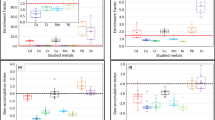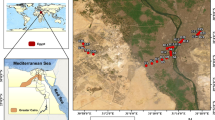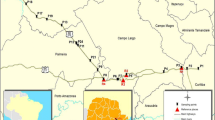Abstract
The continuous expansion of the global vehicle fleet poses a growing threat to environmental quality through heavy metal contamination. In this scenario, monitoring to safeguard public health in urban areas is necessary. Our study involved the collection of 36 street dust and 29 moss samples from roads of a Brazilian metropolis (Recife) with varying traffic intensities as follows: natural reserve (0 vehicles per day), low (< 15,000 vehicles per day), medium (15,000–30,000 vehicles per day), and high (> 30,000 vehicles per day). ICP-AES analysis was performed to determine the concentrations of nine potentially toxic metals (Ba, Cd, Cr, Cu, Mn, Ni, Pb, V, and Zn) to assess the influence of vehicular flow on urban contamination. In the street dust samples, the mean metal concentrations (mg kg−1) exhibited the following order: Ba (503.7) > Mn (303.0) > Zn (144.4) > Cu (95.3) > Cr (56.1) > Pb (34.2) > V (28.7) > Ni (11.3) > Cd (1.5). Conversely, in the moss samples, the metal concentration order was as follows (mg kg−1): Mn (63.8) > Zn (62.5) > Ba (61.0) > Cu (17.7) > Cr (8.0) > V (7.3) > Pb (7.0) > Ni (2.9) > Cd (0.3). Roads with higher traffic volumes exhibited the highest metal enrichments in moss samples for all metals and in dust samples for Cd, Cr, Mn, Ni, and V. However, dust from low-flow roads had higher enrichments for Ba, Cu, and Zn, indicating the influential role of other traffic-related factors in metal deposition. Our findings highlight traffic flow as the predominant source of pollution in urban centers, with both street dust and moss serving as sensitive indicators of metal input attributable to vehicular traffic. These indicators offer valuable insights for urban quality monitoring and pollution control efforts.




Similar content being viewed by others

Data availability
No datasets were generated or analyzed during the current study.
References
Agência Pernambucana de Águas e Clima (APAC) (2018). Monitoramento pluviométrico. http://old.apac.pe.gov.br/meteorologia/monitoramento-pluvio.php. Access 09 April 2022.
Al-Shidi, H., Al-Reasi, H. A., & Sulaiman, H. (2022). Heavy metals levels in road dust from Muscat, Oman: Relationship with traffic volumes, and ecological and health risk assessments. International Journal of Environmental Health, 32(2), 264–276. https://doi.org/10.1080/09603123.2020.1751806
Ali MU, Liu G, Yousaf B, Ullah H, Abbas Q, Munir MAMM, Irshad S (2019). Biomonitoring and health risks assessment of trace elements in various age- and gender-groups exposed to road dust in habitable urban-industrial areas of Hefei, China. Environmental Pollution. https://doi.org/10.1016/j.envpol.2018.10.084
Alvarez JRE, Montero AA, Jiménez NH, Muñiz UO, Padilla AR, Molina RJ, Vera SQ (2001). Nuclear and related analytical methods applied to the determination Cr, Ni, Cu, Zn, Cd and Pb in a red ferralitic soil and Sorghum samples. Journal of Radioanalytical and Nuclear. Chemistry. 247:3:479–486. <https://link.springer.com/article/https://doi.org/10.1023/A:1010640009301>.
Alves CA, Evtyugina M, Vicente AMP, Vicente ED, Nunes TV, Silva PMA, Duarte M AC, Pio CA, Amato F, Querol X (2018). Chemical profiling of PM10 from urban road dust. Science of the Total Environment 634:41–51. <https://doi.org/10.1016/j.scitotenv.2018.03.338>.
Aryal, R., Beecham, S., Sarkar, B., Chong, M. N., Kinsela, A., Kandasany, J., & Vigneswaran, S. (2017). Readily wash–off road dust and associated heavy metals on motorways. Water, Air and Soil Pollution, 228, 1. https://doi.org/10.1007/s11270-016-3178-3
Biondi, C. M., Nascimento, C. W. A., Fabricio Neta, A. B., & Ribeiro, M. R. (2011). Concentrations of Fe, Mn, Zn, Cu, Ni and Co in benchmark soils of Pernambuco, Brazil. Revista Brasileira De Ciência Do Solo, 35, 1057–1066. https://doi.org/10.1590/S0100-06832011000300039
Boquete, M. T., Aboal, J. R., Carballeira, A., & Fernandez, J. A. (2017). Do mosses exist outside of Europe? A biomonitoring reflection. Science of the Total Environment, 593, 567–570. https://doi.org/10.1016/j.scitotenv.2017.03.196
Budai P, Clement A (2018). Spatial distribution patterns of four traffic-emitted heavy metals in urban road dust and the resuspension of brake-emitted particles: Findings of a field study. Transportation Research Part D 62:179–185. <https://doi.org/10.1016/j.trd.2018.02.014>.
Cheng, Z., Chen, L. J., Li, H. H., Lin, J. Q., Yang, Z. B., Yang, Y. X., Xu, X. X., Xian, J. R., Shao, J. R., & Zhu, X. M. (2018). Characteristics and health risk assessment of heavy metals exposure via household dust from urban area in Chengdu, China. Science of the Total Environment, 619, 621–629. https://doi.org/10.1016/j.scitotenv.2017.11.144
Cowden, P., & Aherne, J. (2019). Assessment of atmospheric metal deposition by moss biomonitoring in a region under the influence of a long standing active aluminium smelter. Atmospheric Environment, 201, 84–91. https://doi.org/10.1016/j.atmosenv.2018.12.022
Departamento Nacional de Trânsito (DENATRAN) (2021). Frota de veículos – 2021. https://www.gov.br/infraestrutura/pt-br/assuntos/transito/conteudo-denatran/frota-de-veiculos-2021. Access 10 April 2022.
Di Palma, A., Capozzi, F., Spagnuolo, V., Giordano, S., & Adamo, P. (2017). Atmospheric particulate matter intercepted by moss-bags: Relations to moss trace element uptake and land use. Chemosphere, 176, 361–368. https://doi.org/10.1016/j.chemosphere.2017.02.120
Dong, S., Zhang, S., Wang, L., Ma Ge, Lu. X., & Li, X. (2020). Concentrations, speciation, and bioavailability of heavy metals in street dust as well as relationships with physiochemcal properties: A case study of Jinan City in East China. Environmental Science and Pollution Research, 27, 35724–35737. https://doi.org/10.1007/s11356-020-09761-6
Duong, T. T. T., & Lee, B. K. (2011). Determining contamination level of heavy metals in road dust from busy traffic areas with different characteristics. Journal of Environmental Management, 92, 554–562. https://doi.org/10.1016/j.jenvman.2010.09.010
Enuneku A, Biose, E, Ezemonye L (2017). Levels, distribution, characterization and ecological risk assessment of heavy metals in road side soils and earthworms from urban high traffic areas in Benin Metropolis, Southern Nigeria. Journal of Environmental Chemical Engineering 3:1–21. https://doi.org/10.1016/j.jece.2017.05.019.
Fasano, G., Godoy, R. S., Angiulli, E., Consalvo, A., Franco, C., Mancini, M., Santucci, D., Alleva, E., Ciavardelli, D., Toni, M., Biffali, E., Ekker, M., Canzoniero, L. M. T., & Sordino, P. (2021). Effect of low–dose methylcyclopentadienyl manganese tricarbonyl–derived on the development of diencephalic dopaminergic neurons in zebrafish. Environmental Pollution, 287, 15. https://doi.org/10.1016/j.envpol.2021.117151
Ferreira-Baptista, L., & De Miguel, E. (2005). Geochemistry and risk assessment of street dust in Luanda, Angola: A tropical urban environment. Atmospheric Environment, 39, 4501–4512. https://doi.org/10.1016/j.atmosenv.2005.03.026
Frontasyeva M, Harmens H (2020). Monitoring of atmospheric deposition of heavy metals, nitrogen and pops in Europe using bryophytes. Monitoring Manual, 2020 Survey. https://icpvegetation.ceh.ac.uk/sites/default/files/ICP%20Vegetation%20moss%20monitoring%20manual%202020.pdf.
Fujiwara, F., Rebagliati, R. J., Marrero, J., Gomez, D., & Smichowski, P. (2011). Antimony as a traffic - related element in size - fractionated road dust samples collected in Buenos Aires. Microchemical Journal, 97, 62–67. https://doi.org/10.1016/j.microc.2010.05.006
Gioia, S. M. C. L., Babinski, M., Weiss, D. J., Spiro, B., Kerr, A. A. F. S., Veríssimo, T. G., Ruiz, I., & Prates, J. C. M. (2017). An isotopic study of atmospheric lead in a megacity after phasing out of leaded gasoline. Atmospheric Environment, 149, 70–83. https://doi.org/10.1016/j.atmosenv.2016.10.049
Gope, M., Masto, R. E., George, J., & Balachandran, S. (2018). Tracing source, distribution and health risk of potentially harmful elements (PHEs) in street dust of Durgapur, India. Ecotoxicology and Environmental Safety, 154, 280–293. https://doi.org/10.1016/j.ecoenv.2018.02.042
Grieshop, A. P., Lipsky, E. M., Pekney, N. J., Takahama, S., & Robinson, A. L. (2006). Fine particle emission factors from vehicles in a highway tunnel: Effects of fleet composition and season. Atmospheric Environment, 40, 287–298. https://doi.org/10.1016/j.atmosenv.2006.03.064
Gunawardana C, Egodawatta P, Goonetilleke A (2014). Role of particle size and composition in metal adsorption by solids deposited on urban road surfaces. Environmental Pollution 184: 44–53. https://doi.org/10.1016/j.envpol.2013.08.010.
Harmens, H., Norris, D. A., Sharps, K., Mills, G., Alber, R., Aleksiayenak, Y., Blum, O., Cucu-Man, S. M., Dam, M., Temmerman, L., Ene, A., Fernández, J. A., Martinez-Abaigar, J., Frontasyeva, M., Godzik, B., Jeran, Z., Lazo, P., Leblond, S., Liiv, S., … Zechmeister, H. G. (2015). Heavy metal and nitrogen concentrations in mosses are declining across Europe whilst some “hotspots” remain in 2010. Environmental Pollution, 200, 93–104. https://doi.org/10.1016/j.envpol.2015.01.036
Instituto Brasileiro de Geografia e Estatística (IBGE) (2021). Projeção da população do Brasil e das Unidades da Federação. https://www.ibge.gov.br/apps/populacao/projecao/index.html?utm_source=portal&utm_medium=popclo. Access 05 April 2022.
Instituto Nacional de Meteorologia (INMET) (2019). Banco de dados meteorológicos. https://portal.inmet.gov.br/. Access 05 May 2022
ISO - International Organization for Standardization (1985). Calibration and evaluation of analytical methods and estimation of performance characteristics. Part 1: Statistical evaluation of the linear calibration function.
Jafari, A. J., Kermani, M., Kalantary, R. R., & Arfaeinia, H. (2018). The effects of traffic on levels, distribution and chemical partitioning of harmful metals in the street dust and surface soil from urban areas of Tehran. Iran. Environmental Earth Sciences, 77, 38. https://doi.org/10.1007/s12665-018-7226-8
Kabata-Pendias A (2011). Trace elements in soils and plants , 4th ed n. CRC, Ann Arbor, MI, USA.
Kempter H, Krachler M, Shotyk W, Zaccone C (2017). Major and trace elements in Sphagnum moss from four Southern German bogs, and comparison with available moss monitoring data. Ecological Indicators: 78:19 – 25. https://doi.org/10.1016/j.ecolind.2017.02.029.
Klos, A., Ziembik, Z., Rajfur, M., Dolhanczuk-Srodka, A., Bochenek, Z., Bjerke, J. W., Tommervik, H., Zagajewski, B., & Ziolkowski, P. (2018). Using moss and lichens in biomonitoring of heavy - metal contamination of forest areas in southern and north-eastern Poland. Science of the Total Environment, 627, 438–449. https://doi.org/10.1016/j.scitotenv.2018.01.21
Lazo, P., Steinnes, E., Qarri, F., Allajbeu, S., Kane, S., Stafilov, T., Frontasyeva, M. V., & Harmens, H. (2018). Origin and spatial distribution of metals in moss samples in Albania: A hotspot of heavy metal contamination in Europe. Chemosphere, 190, 337–349. https://doi.org/10.1016/j.chemosphere.2017.09.132
Lima LHV, Nascimento CWA, Silva FBV, Araújo PRM (2023). Baseline concentrations, source apportionment, and probabilistic risk assessment of heavy metals in urban street dust in Northeast Brazil 858:1–15. https://doi.org/10.1016/j.scitotenv.2022.159750.
Liu, E., Yan, T., Birch, G., & Zhu, Y. (2014). Pollution and health risk of potentially toxic metals in urban road dust in Nanjing, a mega-city of China. Science of the Total Environment, 476–477, 522–531. https://doi.org/10.1016/j.scitotenv.2014.01.055
Liu, Y., Xing, J., Wang, S., Fu, X., & Zheng, H. (2018). Source–specific speciation profiles of PM2.5 for heavy metals and their anthropogenic emissions in China. Environmental Pollution, 239, 544–553. https://doi.org/10.1016/j.envpol.2018.04.047
Lv D, Liu Y, Ren L, Huo J, Zhao J, Lu R, Huang Y, Duan L (2023). Assessment of atmospheric heavy metal pollution in Qinghai-Tibet Plateau: Using mosses as biomonitors. Journal of Hazardous Materials 459. https://doi.org/10.1016/j.jhazmat.2023.132181.
Mao, H., Wang, X., Wu, N., Chen, L., Yuan, M., Hu, J., & Chen, Y. (2022). Temporal and Spatial Biomonitoring of Atmospheric Heavy Metal Pollution Using Moss Bags in Xichang, 239, 1–11. https://doi.org/10.1016/j.ecoenv.2022.11368
Men, C., Liu, R., Xu, F., Wang, Q., Guo, L., & Shen, Z. (2018). Pollution characteristics, risk assessment, and source apportionment of heavy metals in road dust in Beijing, China. Science of the Total Environment, 612, 138–147. https://doi.org/10.1016/j.scitotenv.2017.08.123
Naraki, H., Keshavarzi, B., Zarei, M., Moore, F., Abbasi, S., Kelly, F. J., Dominguez, A. O., & Jaafarzadeh, N. (2021). Urban street dust in the Middle East oldest oil refinery zone: Oxidative potential, source apportionment, and health risk assessment of potentially toxic elements. Chemosphere. https://doi.org/10.1016/j.chemosphere.2020.128825
Nemanich, A., Chen, B., & Valento, M. (2021). Toxic boost: Acute, reversible neurotoxicity after ingestion of methylcyclopentadienyl manganese tricarbonyl (MMT) mistaken for an energy drink. American Journal of Emergency Medicine, 42, 261–263. https://doi.org/10.1016/j.ajem.2020.08.087
Nematollahi, M. J., Dehdaran, S., Moore, F., & Keshavarzi, B. (2020). Potentially toxic elements and polycyclic aromatic hydrocarbons in street dust of Yazd, a central capital city in Iran: Contamination level, source identification, and ecological–health risk assessment. Environmental Geochemistry and Health, 43, 485–519. https://doi.org/10.1007/s10653-020-00682-4
Okorie, A., Entwistle, J., & Dean, J. R. (2012). Estimation of daily intake of potentially toxic elements from urban street dust and the role of oral bioaccessibility testing. Chemosphere, 86, 460–467. https://doi.org/10.1016/j.chemosphere.2011.09.047
Qadeer A, Saqib ZA, Ajmal Z, Xing C, Khalil SK, Usman M, Huang Y, Bashir S, Ahmad Z, Ahmed S, Khalid HT, Liu M (2019). Concentrations, pollution indices and health risk assessment of heavy metals in road dust from two urbanized cities of Pakistan: Comparing two sampling methods for heavy metals concentration. Sustainable Cities and Society 53. https://doi.org/10.1016/j.scs.2019.101959.
Rasmussen, P. E., Beauchemin, S., Nugent, M., Dugandzic, R., Lanouette, M., & Chenier, M. (2008). Influence of matrix composition on the bioaccessibility of copper, zinc, and nickel in urban residential dust and soil. Human and Ecological Risk Assess Ment, 14, 351–371. https://doi.org/10.1080/10807030801934960
Schroder, W., & Nickel, S. (2018). Mapping percentile statistics of element concentrations in moss specimens collected from 1990 to 2015 in forests throughout Germany. Atmospheric Environment, 190, 161–168. https://doi.org/10.1016/j.atmosenv.2018.07.030
Skrbic BD, Buljovcic, M, Jovanovic G, Antic I (2018). Seasonal, spatial variations and risk assessment of heavy elements in street dust from Novi Sad, Serbia. Chemosphere 205:452–462. https://doi.org/10.1016/j.chemosphere.2018.04.124.
Stafilov, T., Sajn, R., Barandovski, L., Andonovska, K. B., & Malinovska, S. (2018). Moss biomonitoring of atmospheric deposition study of minor and trace elements in Macedonia. Air Quality, Atmosphere & Health, 11, 137–152. https://doi.org/10.1007/s11869-017-0529-1
Teixeira PC, Donagemma GK, Fontana A, Teixeira WG (2017). Manual de métodos de análise de solo. Embrapa, Brasília.
Tomtom Traffic Index (2022). Measuring congestion worldwide. https://www.tomtom.com/en_gb/traffic-index/ranking/. Access 08 January 2022.
Trujillo-González, J. M., Torres-Mora, M. A., Keesstra, S., Brevik, E. C., & Jiménez-Ballesta, R. (2016). Heavy metal accumulation related to population density in road dust samples taken from urban sites under different land uses. Science of the Total Environment, 553, 636–542. https://doi.org/10.1016/j.scitotenv.2016.02.101
Turap, Y., Talifu, D., Wang, X., Abulizi, A., Maihemuti, M., Tursun, Y., Ding, X., Aierken, T., & Rekefu, S. (2019). Temporal distribution and source apportionment of PM2.5 chemical composition in Xinjiang, NW–China. Atmospheric Research, 218, 257–268. https://doi.org/10.1016/j.atmosres.2018.12.010
USEPA - United States Environmental Protection Agency (1996). Method 3050B: Acid digestion of sediments sludges and soils. Available at: https://www.epa.gov/sites/production/files/2015-06/documents/epa-3050b.pdf. Accessed 14 May 2020.
USEPA - United States Environmental Protection Agency (2007). Method 6200: Field portable x – ray fluorescence spectrometry for the determination of elemental concentrations in soils and sediment. https://www.epa.gov/sites/default/files/2015-12/documents/6200.pdf. Access 05 May 2021.
USSL Staff - United States Salinity Laboratory Staff (1954). Diagnosis and improvement of saline and alkali soils. Washington DC, US Department of Agriculture. https://www.ars.usda.gov/ARSUserFiles/20360500/hb60_pdf/hb60complete.pdf.
Varela Z, Boquete MT, Fernández JA, Martínez-Abaigar J, Núnez-Oliveira E, Aboal, JR (2023). Mythbusters: Unravelling the pollutant uptake processes in mosses for air quality biomonitoring 148:1–10. https://doi.org/10.1016/j.ecolind.2023.110095.
Wagner, S., Hüffer, T., Klöckner, P., Wehrhahn, M., Hofmann, T., & Reemtsma, T. (2018). Tire wear particles in the aquatic environment–A review on generation, analysis, occurrence, fate and effects. Water Research, 139, 83–100. https://doi.org/10.1016/j.watres.2018.03.051
Wahab MIA, Razak WMAA, Sahani M, Khan MF (2020). Characteristics and health effect of heavy metals on non-exhaust road dusts in Kuala Lumpur. Science of The Total Environment 703 https://doi.org/10.1016/j.scitotenv.2019.135535.
Wang X, Wang W, Jiao S, Yu A, Hu C, Wang L (2015). The effects of air pollution on daily cardiovascular diseases hospital admissions in Wuhan from 2013 to 2015. Atmospheric Environment 182: 307–312. https://www.sciencedirect.com/science/article/pii/S1352231018301882.
Yang X, Mills-Beale J, You Z (2017). Chemical characterization and oxidative aging of bio - asphalt and its compatibility with petroleum asphalt. Journal of Cleaner Production 142:1837–1847. https://doi.org/10.1016/j.jclepro.2016.11.100.
Zhang, Y., Cai, J., Wang, S., He, K., & Zheng, M. (2017). Review of receptor–based source apportionment research of fine particulate matter and its challenges in China. Science of the Total Environment, 586, 917–929. https://doi.org/10.1016/j.scitotenv.2017.02.071
Acknowledgements
The authors thank the National Council for Scientific and Technological Development (CNPq), Coordination for the Improvement of Higher Education Personnel (CAPES), and Foundation for the Support of Science and Technology of Pernambuco (FACEPE).
Funding
This work was supported by the Brazilian institution FACEPE under Grant Number 0430–5.01/14 and Coordination for the Improvement of Higher-Level Personnel (CAPES).
Author information
Authors and Affiliations
Contributions
Luiz Henrique Vieira Lima: methodology, formal analysis, software, writing—original draft, writing—review and editing. Fernando Bruno Vieira da Silva: methodology, software, writing—review and editing. Paula Renata Muniz Araújo: writing—review and editing. Alfredo Montero Alvarez: visualization, writing—review and editing. Kátia Cavalcanti Pôrto: methodology, writing—review and editing. Clístenes Williams Araújo do Nascimento: resources, writing—review and editing, supervision.
Corresponding author
Ethics declarations
Ethical approval
All authors have read, have understood, and have complied as applicable with the statement on “Ethical responsibilities of Authors” as found in the Instructions for Authors.
Competing interests
The authors declare no competing interests.
Additional information
Publisher's Note
Springer Nature remains neutral with regard to jurisdictional claims in published maps and institutional affiliations.
Supplementary Information
Below is the link to the electronic supplementary material.
Rights and permissions
Springer Nature or its licensor (e.g. a society or other partner) holds exclusive rights to this article under a publishing agreement with the author(s) or other rightsholder(s); author self-archiving of the accepted manuscript version of this article is solely governed by the terms of such publishing agreement and applicable law.
About this article
Cite this article
Lima, L.H.V., da Silva, F.B.V., Araújo, P.R.M. et al. Assessing heavy metal contamination in a Brazilian metropolis: a case study with a focus on (bio)indicators. Environ Monit Assess 196, 481 (2024). https://doi.org/10.1007/s10661-024-12661-8
Received:
Accepted:
Published:
DOI: https://doi.org/10.1007/s10661-024-12661-8



